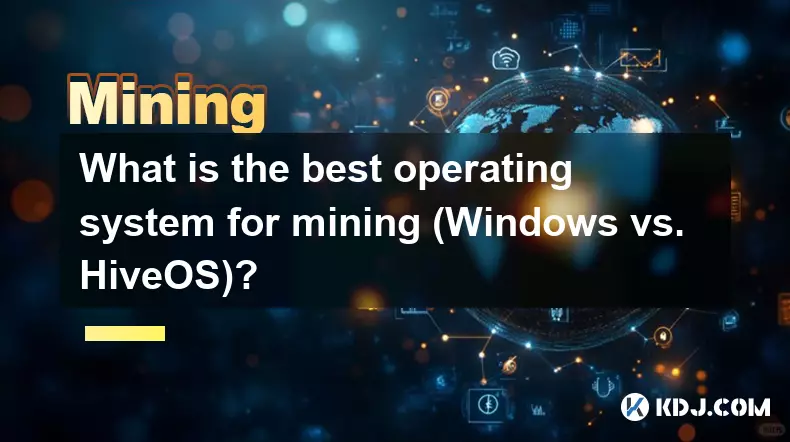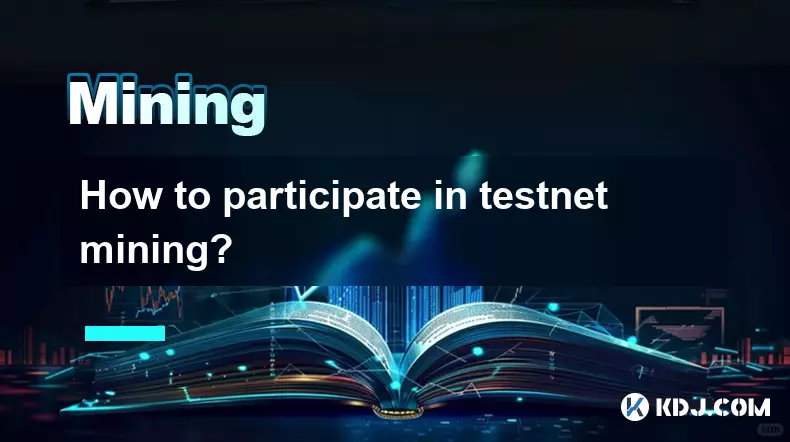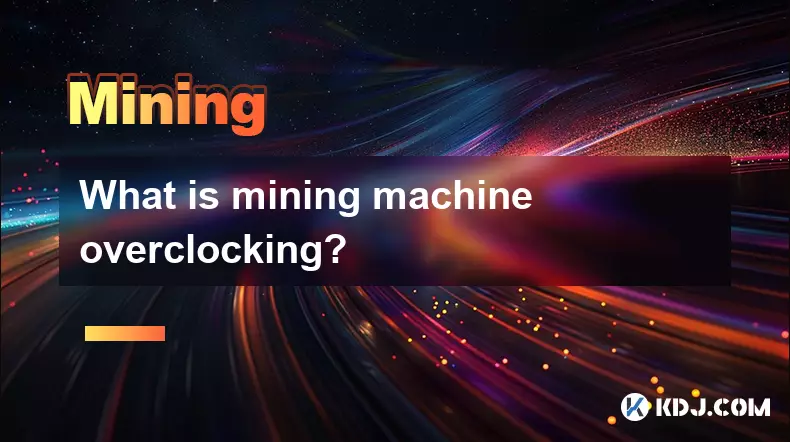-
 bitcoin
bitcoin $109667.069529 USD
-3.03% -
 ethereum
ethereum $3936.685804 USD
-4.07% -
 tether
tether $1.000493 USD
0.01% -
 xrp
xrp $2.771823 USD
-4.74% -
 bnb
bnb $957.805027 USD
-5.34% -
 solana
solana $196.735100 USD
-6.68% -
 usd-coin
usd-coin $0.999727 USD
-0.01% -
 dogecoin
dogecoin $0.227355 USD
-5.12% -
 tron
tron $0.335205 USD
-0.81% -
 cardano
cardano $0.779256 USD
-3.59% -
 ethena-usde
ethena-usde $0.999900 USD
-0.06% -
 hyperliquid
hyperliquid $42.492095 USD
-6.61% -
 chainlink
chainlink $20.501853 USD
-4.34% -
 avalanche
avalanche $28.952606 USD
-11.21% -
 stellar
stellar $0.356038 USD
-3.93%
What is the best operating system for mining (Windows vs. HiveOS)?
HiveOS offers superior stability, security, and remote management for mining rigs, with optimized performance and lower operational costs compared to Windows.
Sep 13, 2025 at 09:00 am

Performance and Stability in Mining Environments
1. HiveOS is built specifically for cryptocurrency mining, offering a lightweight architecture optimized for GPU and ASIC performance. Its core functionality focuses on maximizing hash rates while minimizing system overhead.
- Windows, while versatile, runs background services and visual components that consume memory and CPU resources, potentially reducing available power for mining operations.
- HiveOS uses a Linux foundation, which is known for stability during long-running processes. Miners report fewer crashes and reboots compared to Windows setups.
- The streamlined nature of HiveOS allows faster boot times and quicker recovery after power outages, minimizing downtime in large-scale operations.
- Windows may require additional configuration to disable updates and background apps, which can interfere with continuous mining if not managed properly.
Hardware Compatibility and Driver Support
1. HiveOS supports a wide range of GPUs from AMD and NVIDIA, with pre-configured drivers that are regularly updated for optimal mining efficiency.
- Windows offers broader initial hardware compatibility, especially for newer GPU models, allowing users to install the latest drivers directly from manufacturers.
- HiveOS includes built-in tools to flash and manage GPU BIOS, enabling voltage and clock adjustments that are harder to perform on Windows.
- Some ASIC miners and specialized mining rigs are designed to work natively with Linux-based systems like HiveOS, ensuring seamless integration.
- On Windows, miners often need third-party tools to achieve similar control over hardware, increasing complexity and potential points of failure.
Remote Management and Monitoring
1. HiveOS provides a cloud-based dashboard that allows miners to monitor all rigs from a single interface, regardless of physical location.
- Real-time alerts for temperature spikes, hash rate drops, or offline status are built into HiveOS, enabling immediate response to issues.
- Windows requires additional software such as TeamViewer or mining-specific dashboards to achieve similar monitoring capabilities, often resulting in fragmented oversight.
- HiveOS supports API integration with major mining pools and services, automating tasks like worker registration and payout tracking.
- Batch configuration in HiveOS allows changes to be pushed across multiple rigs simultaneously, reducing manual setup time in large farms.
Security and System Maintenance
1. HiveOS operates in read-only mode by default, protecting the core system from corruption due to sudden shutdowns or malware.
- Windows is more vulnerable to ransomware and other threats, especially when connected to the internet and running third-party mining software.
- HiveOS receives regular security patches through its update system, with changes applied without disrupting mining operations.
- Automatic reboots and fail-safes in HiveOS ensure that unresponsive rigs return to operation without manual intervention.
- Windows systems often require scheduled maintenance windows, during which mining must be paused, leading to potential revenue loss.
Cost and Licensing Considerations
1. HiveOS offers a free tier with basic features, making it accessible for small-scale miners, while premium features are available through affordable subscriptions.
- Windows requires a valid license for each installation, which can become costly when deploying across dozens or hundreds of mining rigs.
- HiveOS eliminates the need for antivirus software and additional utilities, reducing both cost and system load.
- The absence of mandatory updates in HiveOS prevents unexpected reboots, a common issue in Windows that disrupts mining sessions.
- Long-term operational savings with HiveOS come from reduced power consumption, lower failure rates, and less administrative overhead.
Frequently Asked Questions
Can I use HiveOS with a desktop GPU setup?Yes, HiveOS supports consumer-grade GPUs and is commonly used in home mining rigs. It can be installed via USB and runs efficiently even on older hardware.
Does HiveOS support all mining algorithms?HiveOS is compatible with most major algorithms including Ethash, KawPow, and Autolykos. Miners can configure custom mining software through the dashboard.
Is it possible to switch from Windows to HiveOS without losing hardware?Yes, transitioning to HiveOS does not affect your mining hardware. You only need to flash the OS onto a USB drive and boot from it, preserving your GPUs and other components.
How does HiveOS handle internet connectivity issues?HiveOS includes offline mining modes and local configuration storage, allowing rigs to continue operating temporarily without internet access. Sync resumes once connectivity is restored.
Disclaimer:info@kdj.com
The information provided is not trading advice. kdj.com does not assume any responsibility for any investments made based on the information provided in this article. Cryptocurrencies are highly volatile and it is highly recommended that you invest with caution after thorough research!
If you believe that the content used on this website infringes your copyright, please contact us immediately (info@kdj.com) and we will delete it promptly.
- Big Rocking Horse, Coin, and Ice Cream: An Aussie Icon's Sweet Ride
- 2025-09-26 10:45:16
- Pi Network, Price Forecast, and the Meme Market: A New York Minute
- 2025-09-26 10:25:14
- AIXA Miner: Revolutionizing Bitcoin Mining with Cloud Solutions
- 2025-09-26 10:45:16
- Mid-Cap Altcoins: Crypto Buys with Breakout Potential
- 2025-09-26 10:50:01
- BullZilla Presale: Riding the Crypto Wave in September 2025
- 2025-09-26 10:50:01
- Litecoin ETF Buzz, XRP Breakout Dreams, and BlockDAG's Deployment: Crypto's Wild West in '25
- 2025-09-26 10:50:01
Related knowledge

The difference between staking and mining
Sep 24,2025 at 05:18am
Understanding Staking in the Cryptocurrency Ecosystem1. Staking involves holding funds in a cryptocurrency wallet to support the operations of a block...

How to participate in testnet mining?
Sep 22,2025 at 09:18am
Understanding Testnet Mining in the Crypto Ecosystem1. Testnet mining is a method used by blockchain developers to simulate real-world conditions on a...

How to dispose of abandoned mining machines?
Sep 19,2025 at 08:19pm
Assessing the Condition of Abandoned Mining Rigs1. Begin by inspecting each mining machine for visible damage, corrosion, or missing components. Machi...

How to identify high-quality mining pools?
Sep 21,2025 at 03:19pm
Reputation and Track Record1. A mining pool’s reputation is built over time through consistent performance and transparency. Pools that have operated ...

Advantages of decentralized mining pools
Sep 20,2025 at 04:36pm
Enhanced Security and Resistance to Censorship1. Decentralized mining pools operate on blockchain-based smart contracts, eliminating the need for a ce...

What is mining machine overclocking?
Sep 21,2025 at 07:19pm
Understanding Mining Machine Overclocking1. Mining machine overclocking refers to the process of increasing the operating frequency of a cryptocurrenc...

The difference between staking and mining
Sep 24,2025 at 05:18am
Understanding Staking in the Cryptocurrency Ecosystem1. Staking involves holding funds in a cryptocurrency wallet to support the operations of a block...

How to participate in testnet mining?
Sep 22,2025 at 09:18am
Understanding Testnet Mining in the Crypto Ecosystem1. Testnet mining is a method used by blockchain developers to simulate real-world conditions on a...

How to dispose of abandoned mining machines?
Sep 19,2025 at 08:19pm
Assessing the Condition of Abandoned Mining Rigs1. Begin by inspecting each mining machine for visible damage, corrosion, or missing components. Machi...

How to identify high-quality mining pools?
Sep 21,2025 at 03:19pm
Reputation and Track Record1. A mining pool’s reputation is built over time through consistent performance and transparency. Pools that have operated ...

Advantages of decentralized mining pools
Sep 20,2025 at 04:36pm
Enhanced Security and Resistance to Censorship1. Decentralized mining pools operate on blockchain-based smart contracts, eliminating the need for a ce...

What is mining machine overclocking?
Sep 21,2025 at 07:19pm
Understanding Mining Machine Overclocking1. Mining machine overclocking refers to the process of increasing the operating frequency of a cryptocurrenc...
See all articles










































































